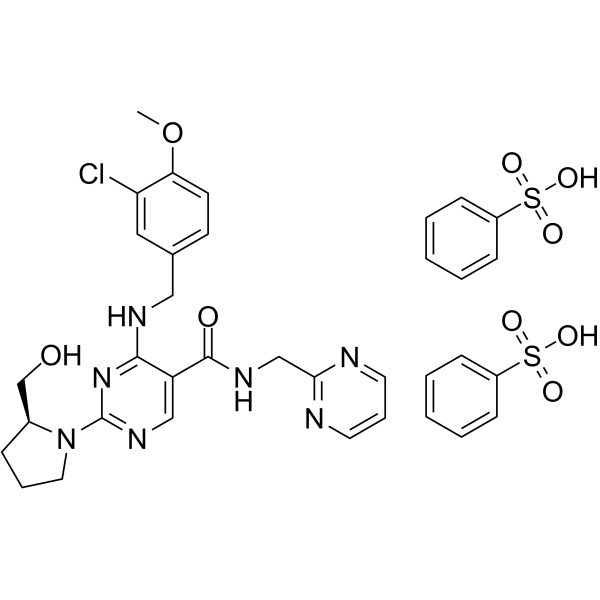Avanafil dibenzenesulfonate

Avanafil dibenzenesulfonate structure
|
Common Name | Avanafil dibenzenesulfonate | ||
|---|---|---|---|---|
| CAS Number | 330784-48-0 | Molecular Weight | 800.30 | |
| Density | N/A | Boiling Point | N/A | |
| Molecular Formula | C35H38ClN7O9S2 | Melting Point | N/A | |
| MSDS | N/A | Flash Point | N/A | |
Use of Avanafil dibenzenesulfonateAvanafil (TA-1790) dibenzenesulfonate is a potent and selective phosphodiesterase-5 (PDE-5) inhibitor with IC50 values of 5.2 nM, 630 nM, 5700 nM, 6200 nM, 12000 nM, 27000 nM, 51000 nM and 53000 nM for PDE-5, PDE-6, PDE-4, PDE-10, PDE-8, PDE-7, PDE-2 and PDE-1, respectively. Avanafil dibenzenesulfonate activates NO/cGMP/PKG signaling-pathway to decrease loss in BMD, bone atrophy, and oxidative stress. Avanafil dibenzenesulfonate inhibits cyclic guanosine monophosphate (cGMP) hydrolysis and thus increases cGMP levels. Avanafil dibenzenesulfonate can be used for the research of erectile dysfunction and osteoporosis[1][2][3]. |
| Name | Avanafil dibenzenesulfonate |
|---|
| Description | Avanafil (TA-1790) dibenzenesulfonate is a potent and selective phosphodiesterase-5 (PDE-5) inhibitor with IC50 values of 5.2 nM, 630 nM, 5700 nM, 6200 nM, 12000 nM, 27000 nM, 51000 nM and 53000 nM for PDE-5, PDE-6, PDE-4, PDE-10, PDE-8, PDE-7, PDE-2 and PDE-1, respectively. Avanafil dibenzenesulfonate activates NO/cGMP/PKG signaling-pathway to decrease loss in BMD, bone atrophy, and oxidative stress. Avanafil dibenzenesulfonate inhibits cyclic guanosine monophosphate (cGMP) hydrolysis and thus increases cGMP levels. Avanafil dibenzenesulfonate can be used for the research of erectile dysfunction and osteoporosis[1][2][3]. |
|---|---|
| Related Catalog | |
| Target |
PDE5:5.2 nM (IC50) PDE6:630 nM (IC50) PDE4:5700 nM (IC50) PDE10:6200 nM (IC50) PDE7:27000 nM (IC50) PDE2:51000 nM (IC50) PDE1:53000 nM (IC50) |
| In Vitro | Avanafil (TA-1790) dibenzenesulfonate (0.01-1000 µM) enhances by 45% for electrical field stimulation (1-20 Hz)-induced relaxation responses in corpus cavernosum strips from the diabetic group[2]. |
| In Vivo | Avanafil (TA-1790) dibenzenesulfonate (10 mg/kg; p.o.; daily, for 30 d; male rat) increases angiogenesis in bone tissue via the activation of NO, cGMP and PKG (NO/cGMP/PKG) signaling-pathway and significantly decreases dexamethasone-induced loss in BMD, bone atrophy, and oxidative stress[1]. Avanafil (TA-1790) dibenzenesulfonate (10 µM; ICI; once, for 10 weeks) improves erectile responses in T2DM rats[2]. Animal Model: Male rat model of glucocorticoid-induced osteoporosis (GIOP)[1] Dosage: 10 mg/kg Administration: Oral administration; daily, for 30 days Result: Decreased the level of eNOS, NO, PDE-5, PICP, MDA, CoQ10/CoQ10H and 8-OHdG/108dG. Increased the level of cGMP, PKG, Cortisol and CTCP. Animal Model: Male rat model of glucocorticoid-induced osteoporosis (GIOP)[1] Dosage: 10 mg/kg Administration: Oral administration; daily, for 30 days Result: Increased right femur trabecular bone thickness and epiphyseal bone width. Animal Model: Male T2DM Sprague Dawley rats[2] Dosage: 10 µM Administration: Intracavernous injection; once, for 10 weeks Result: Increased in ICP/MAP in response to nerve stimulation and increased total ICP values. |
| References |
| Molecular Formula | C35H38ClN7O9S2 |
|---|---|
| Molecular Weight | 800.30 |